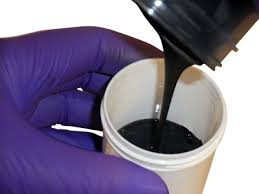 As we have discussed so many times in the past, graphene — the one atom thick, nearly transparent ‘miracle material’ consisting of pure carbon — could have incredible potential in numerous industries. When combining the nearly infinite uses of additive manufacturing with the incredible material properties of graphene, we are presented with what could be the ingredients to a number of groundbreaking new applications for both technologies.
As we have discussed so many times in the past, graphene — the one atom thick, nearly transparent ‘miracle material’ consisting of pure carbon — could have incredible potential in numerous industries. When combining the nearly infinite uses of additive manufacturing with the incredible material properties of graphene, we are presented with what could be the ingredients to a number of groundbreaking new applications for both technologies.
Today one such application has been presented to us, thanks in part to Graphene 3D Lab Inc’s CEO, Daniel Stolyarov. At the Inside 3D Printing Conference in Santa Clara today, Stolyarov was on hand to present and discuss recent developments regarding his company’s work involving 3D printed graphene batteries.
This process could revolutionize the development of electronics, allowing for the integration of lightweight, highly efficient batteries, printed within a product. Stolyarov was on hand to tout all the possible implications that these new printable batteries may have.
“Our ability to create a 3D printable battery and other electrochemical devices will play a significant role in the growth of commercial applications of 3D printing technology,” he said.
Graphene 3D Lab, which a couple of months ago submitted a provisional patent application to the US Patent and Trademark Office for recent innovations in the methods and materials for the 3D printing of batteries, is working toward a product that, if successful, could change the way a number of products are constructed with integrated electrical components.
The company is currently working on early stage prototypes of their battery which can be printed on an FDM printer. The business model behind Graphene 3D Labs is to provide the graphene-based nanocomposite filament to companies as a tool for printing anything from batteries to other conductive electronics. The filament — a composite made up of thermoplastics and approximately 10% graphene, which can be used within a  typical FFF or FDM 3D printer — would put the power of printing conductive elements into the hands of anyone able to afford such a printer.
typical FFF or FDM 3D printer — would put the power of printing conductive elements into the hands of anyone able to afford such a printer.
One of the main hindrances to printing the company’s graphene-based battery is that the prototype consists of 5 different graphene composite materials. Because of this, in order to print the battery, an FDM/FFF printer capable of printing in 5 materials with 5 hotends is required. Since such a printer has not been introduced to the mass market, Stolyarov told us that his company is actually working with other manufacturers to introduce such a device into the market.
In addition to thermoplastic-based materials, 3D Graphene Lab has the capability to develop graphene nanocomposite powders for selective laser sintering as well. Because the market for such printers is much smaller, however, they are currently focusing their efforts on thermoplastics.
The first prototype is a zinc-air battery, and Stolyarov expects to be able to print lithium-ion batteries as well sometime in the future. Just where this technology will take Graphene 3D Labs and the 3D printing industry in general is yet to be seen, but the possibilities are certainly exciting. Let’s hear your thoughts on this story in the Graphene 3D Labs forum thread on 3DPB.com. Check out the video below, courtesy of Gary Anderson of 3DPrintingStocks.com, showing the 3D Printing of the battery.
Subscribe to Our Email Newsletter
Stay up-to-date on all the latest news from the 3D printing industry and receive information and offers from third party vendors.
Print Services
Upload your 3D Models and get them printed quickly and efficiently.
You May Also Like
Heating Up: 3D Systems’ Scott Green Discusses 3D Printing’s Potential in the Data Center Industry
The relentless rise of NVIDIA, the steadily increasing pledges of major private and public investments in national infrastructure projects around the world, and the general cultural obsession with AI have...
3DPOD 260: John Hart on VulcanForms, MIT, Desktop Metal and More
John Hart is a Professor at MIT; he´s also the director of the Laboratory for Manufacturing and Productivity as well as the director of the Center for Advanced Production Technologies....
Etsy Design Rule Change Reduces Selection of 3D Printed Goods
Online marketplace Etsy has implemented a rule change requiring all 3D printed goods on the site to be original designs. The update to the site’s Creativity Standards states, ¨Items produced using...
E-Beam OEM Wayland Additive Partners with USC Racing to 3D Print Titanium Exhaust Collector
Every year, standards organization SAE International holds a competition called Formula SAE, in which students from both undergraduate and graduate programs design, build, and race small formula-style race cars. For...


































